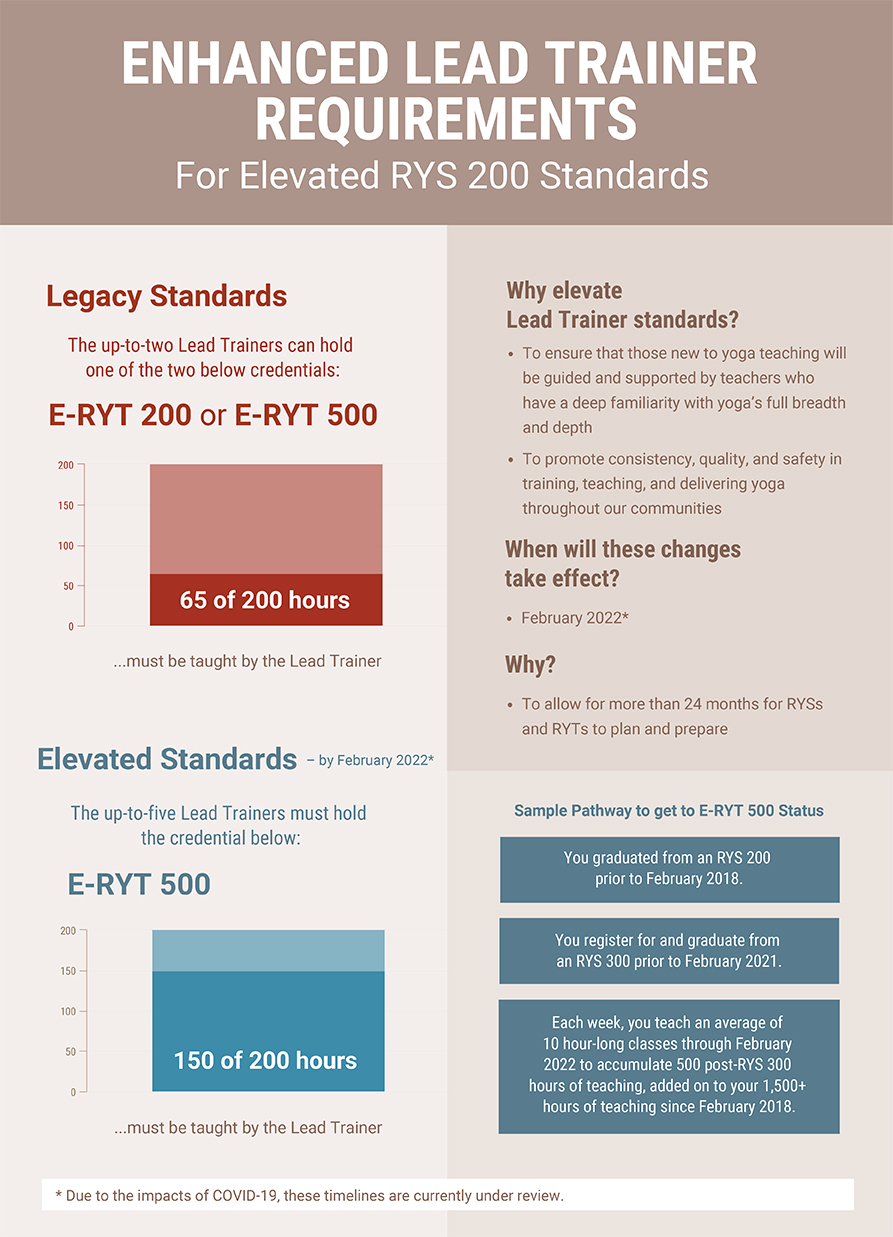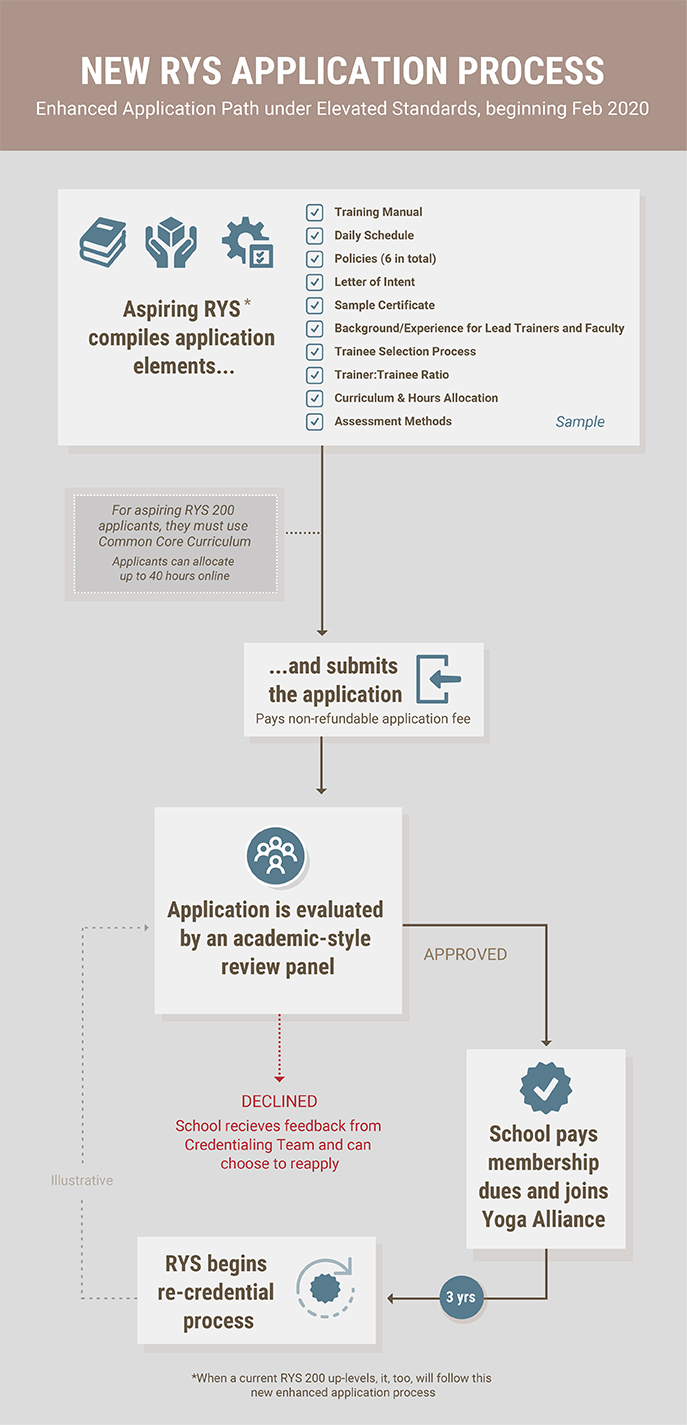Our Standards
> Elevated RYS 200 Standards
Elevated RYS 200 Standards
Last Updated: July 19, 2023
Please note: These standards were launched prior to the COVID-19 pandemic that prompted substantial shifts in the yoga landscape. Since then, we have revisited and revised our standards to ensure they continue to meet the current and evolving needs of the broader yoga community.
Core Curriculum
In early 2020, Yoga Alliance launched new Elevated Standards to replace our Legacy Standards underlying the foundational Registered Yoga School (RYS) 200 credential. This adaptation substantially increases the baseline for this credential, providing consistency across RYS 200s and building confidence in the quality and safety of service that our members deliver to their communities.
- Legacy RYS 200 Standards: YA standards crafted and implemented prior to February 27, 2020. RYS 200 programs were initially asked to up-level by February 2022, however, due to COVID-19's impacts on our community, previously stated dates and deadlines are currently under review. Members will be informed of all relevant changes as they develop.
- Elevated RYS 200 Standards: Enhanced standards launched on February 27, 2020 as a result of the community-led Standards Review Project. All aspiring RYS 200 programs must now apply under these standards.
Within the Elevated Standards is a shared core curriculum inclusive of lineage, style, and methodology. This curriculum includes a clear breakdown of four Educational Categories and 12 competencies encompassing respective sub-competencies [?]—all of which must be tested [?] for integration and application of knowledge.
Under these modernized standards, each RYS also assesses the knowledge, skills, and experience of its trainees prior to certifying them as 200-hour teachers against this core curriculum.
| Techniques, Training, Practice
|
Anatomy & Physiology
|
Yoga Humanities
|
Professional Essentials
|
| 75 hours
|
30 hours
|
30 hours
|
50 hours
|
|
Asana
- Historical context
- Poses specific to RYS's lineage—must include sukhasana and savasana
- Complete sequencing (asana, pranayama, meditation) to achieve particular effect safely
- Shared anatomical and alignment principles plus contraindications
Pranayama & Subtle Body
- Historical context
- Effects of pranayama on anatomy and subtle body
- Complete sequencing of pranayama safely, including alternatives and adaptations Ujjayi, Nadi Shodhana, Kapalabhati, among others
- Koshas, kleshas, chakras, nadis and prana vayus
Meditation
- Key meditation terms
- Meditation methods by lineage
- Ability to practice school's chosen meditation practice
- Chanting, mantras, and mudras
|
Anatomy
Skeletal system, incl.:
- Major bones
- Types of joints
- Major muscles involved in asana
- Types of muscle contraction
Physiology
Nervous system, incl.:
- ‘fight, flight, freeze’ stress response, vagal theory, overall mind-body connection
- Cardiovascular/circulatory, endocrine, digestive systems as they relate to yoga practice
- Respiratory system, incl. muscles that affect breathing, involuntary vs voluntary breath, how air enters and leaves body
Biomechanics
- Types of joint movements
- Joint stabilization
- Safe movement as it pertains to balancing, stretching, awareness, and physical limitations
- Contraindications, misalignments, adaptations
|
History
- Term ‘yoga’
- School’s lineage, style, and methodology
- Dates and key ideas such as the Vedas, Vedanta, Hatha, Colonial, Modern
Philosophy
- Definition of yoga and key terms
- Relationship between asana, pranayama, meditation per school’s approach
- Familiarity w/ major yogic texts (i.e., Yoga Sutras, Bhagavad Gita, Upanishads, Hatha Yoga Pradipika)
- Self-reflection on how philosophy relates to practice
Ethics
- Awareness of Yoga Sutras or similar yogic ethical precepts
- Relationship to Yoga Alliance Ethical Commitment including Scope of Practice, Code of Conduct, and Equity Position Statement
- Comprehension of and responsibility to increase equity in yoga
- Accountability measures
- Self-reflection on how yoga ethics relate to practice and teaching
|
Teaching Methodology
- Sequencing
- Pace
- Environment Cueing (verbal,visual, physical)
- Class management
Professional Development
- Yoga-related professional organizations, including the Yoga Alliance credentialing process
- Ethical Commitment, including Scope of Practice, Code of Conduct and Equity Position Statement
- Lifetime of learning and continuing education
- General professionalism, including timeliness, consistency, cleanliness
- Marketing and promotion
- Liability insurance, waivers, invoicing
Practicum (Practice Teaching)
- Knowledge,skills, experience across 12 key competencies
- Mentorship component,incl. apprenticeship, feedback
|
|
Plus Elective Hours (maximum of 15 hours)
Elective Hours must fall under one of the 4 Core Curriculum categories
|
While the core curriculum requires 200 hours of instruction and training embodying the Educational Categories and competencies above, RYS 200s are encouraged to offer additional hours as desired or needed to expand upon their unique yoga focus(es). We value the respective points of view and areas of interest for all yoga school members, and promote additional education to support the lineage, style, or methodology unique to them.
What has changed?
When compared to our Legacy Standards, the Elevated Standards do the following:
- Embrace an Hours + Competencies model centered around a common core curriculum made up of four Educational Categories, 12 competencies, and many sub-competencies, moving away from strictly an hours-based model based on Educational Categories;
- Require 100% of the minimally-required hours to be classroom hours [?] tied directly to the core curriculum and learning objectives;
- Allow for 100% of classroom hours to be delivered via distance learning, with the requirement that 15% of the hours be in a synchronous (real-time) format;
- Require RYSs to assess the knowledge, skills, and experience of their trainees prior to certifying them as 200-hour teachers (something that many Legacy RYSs currently do as a “best practice”); and
- Increase the requirements of the RYS 200 Lead Trainer.
Lead Trainer Requirements
As part of the Standards Review Project, we took an in depth look at what qualified yoga teachers to lead teacher training programs around the world—the results of which are detailed within the Teacher Trainer Qualifications working group paper. From this exploration, we adapted the Lead Trainer Requirements within the Elevated Standards to better promote consistency, quality, and safety within YTT programs.
Notably, under the Elevated Standards, all Lead Trainers must hold the E-RYT 500 credential and teach at least 150 of the minimally-required 200 hours of the foundational teacher training program. Each RYS 200 may also have up to five Lead Trainers.

Registered Yoga School (RYS) Application Process
New applicants for any Registered Yoga School (RYS) credential will apply under the strengthened application and review process, providing greater shared accountability to meet or exceed Yoga Alliance's standards.
This enhanced application allows for a deeper understanding of an applicant’s yoga teacher training program, including schedule, curriculum, assessment methods, and training manual(s) and other materials.

Application Resources
We respect and value the work, energy, time, and love that goes into becoming a Registered Yoga School. To help, we’ve put together a variety of resources to streamline the RYS applicant process.